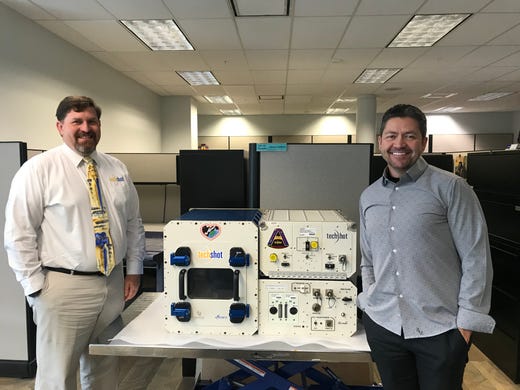For Kenneth Church, sending a 3D printer that could one day print viable human organs to the International Space Station was a personal decision.
Church’s daughter, Kendie Hope, suffered from a diaphragmatic hernia when she was little that prevented her right lung from growing.
“It turned out that my kid shouldn’t have lived,” Church, who is the CEO of nScrypt — an Orlando-based manufacturer that sells 3D printing equipment, said.
Now, 26 years old, Kendie only has one lung.
“My goal in life, and we’ll see how it goes, is to figure out how to grow the other one,” Church said.
Since 2015, nScrypt and Techshot Inc., an Indiana-based developer of spaceflight equipment, partnered together to develop a 3D printer capable of producing human tissue.
Now, that 3D bio-printer, called the 3D BioFabrication Facility or BFF, will hitch a ride on SpaceX’s Falcon 9 rocket on Wednesday as it makes its way to the space station.
For its 18th mission under NASA’s Commercial Resupply Services, a SpaceX Dragon cargo spacecraft will blast off from Cape Canaveral Air Force Station Launch Complex 40. The spacecraft had previously visited the space station in April 2015 and December 2017, according to SpaceX.
Teams are looking at an instantaneous window – meaning it must launch at that time or be forced to delay another day – at 6:24 p.m., July 24, the 50th anniversary of when Apollo 11 splashdown in the Pacific Ocean.
Once docked at the ISS, the spacecraft will deliver hundreds of pounds of supplies to support dozens of the more than 250 science investigations occurring onboard. Dragon capture is scheduled for 7 a.m. Friday and will stay at the space station for about a month before returning back to Earth.
The rocket’s first stage booster meanwhile will attempt an automatic landing at Cape Canaveral Air Force Station’s Landing Zone 1 shortly after liftoff, generating sonic booms that will reverberate through the area.
Weather conditions for Wednesday evening’s launch are currently at 40% “go” as calculated by the Air Force.
“Launch conditions are expected to become less favorable into the middle of next week with greater storm and cloud potential,” according to the 45th Weather Squadron.
Once docked at the space station, the 600-pound 3D BFF printer, which is the size of a small refrigerator, will stay there for at least nine to 10 months where it will print human cardiovascular tissue in microgravity, something that has never been done before, according to Church.
A common problem researchers face when attempting to 3D print human tissue here on Earth, is being able to maintain the tissue’s structure. Due to Earth’s gravity, the tissue collapses under its own weight, resulting in nothing more than a gooey puddle.
In order to prevent this, researchers can attempt to use scaffolding or non-biological materials to keep the tissue from dissolving, but that’s not the preferred method when attempting to produce pure human tissues. That’s where space comes in.
“The nice part in weightlessness conditions is that structure doesn’t have to have everything in it that’s bad for biology that you have to have on the ground,” Techshot’s chief scientist Eugene Boland said. “You don’t have to have extra scaffolding with non-biological materials. You don’t have to add chemical cross-linking agents to make it thicker; you don’t have to add everything that’s just not found in a regular biological tissue.”
“So we can print with pure biology,” he said.
Both Church and Boland estimate it takes roughly two to four weeks to print and maintain the hard tissue, after which it can be returned back to Earth for further analysis.
Operated via computers on the ground, the only work astronauts will have to do is place the cassettes containing all the biological materials needed in producing the tissue inside the 3D printer. From there, the printer and the teams on the ground will take care of everything else.
The goal is to use 12 cassettes to print multiple cardiovascular tissues during the duration of the printer’s stay on the ISS. The cassettes will return individually over the next year for further evaluation.
The $7 million project hopes to revolutionize the medical industry, bringing more accessibility for people to get healthy organs than having to wait, with sometimes no success, for an organ on the transplant list.
“It’s not going to happen next year,” Church said. “But we’ll see what happens in the next five to 10 years.”
Still, researchers remain optimistic.
“We’re just gunning to be successful,” Church said. “At a minimum, we’re going to learn some amazing things that are going to help every tissue engineer on the planet. At a maximum, we’re going to be growing organs on the station and sending them back down to Earth.”
Saturday, May 4, 2019: SpaceX launches a Falcon 9 rocket and Dragon spacecraft for the CRS-17 mission to resupply the International Space Station. Florida Today

